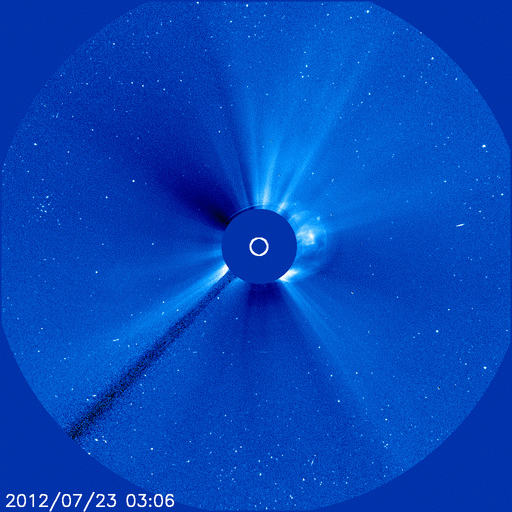JohnGaltfla
#NeverTrump
Earth survived near-miss from 2012 solar storm: NASA






Washington (AFP) - Back in 2012, the Sun erupted with a powerful solar storm that just missed the Earth but was big enough to "knock modern civilization back to the 18th century," NASA said.
The extreme space weather that tore through Earth's orbit on July 23, 2012, was the most powerful in 150 years, according to a statement posted on the US space agency website Wednesday.
However, few Earthlings had any idea what was going on.
"If the eruption had occurred only one week earlier, Earth would have been in the line of fire," said Daniel Baker, professor of atmospheric and space physics at the University of Colorado.
Instead the storm cloud hit the STEREO-A spacecraft, a solar observatory that is "almost ideally equipped to measure the parameters of such an event," NASA said.
Scientists have analyzed the treasure trove of data it collected and concluded that it would have been comparable to the largest known space storm in 1859, known as the Carrington event.
It also would have been twice as bad as the 1989 solar storm that knocked out power across Quebec, scientists said.
"I have come away from our recent studies more convinced than ever that Earth and its inhabitants were incredibly fortunate that the 2012 eruption happened when it did," said Baker.
The National Academy of Sciences has said the economic impact of a storm like the one in 1859 could cost the modern economy more than two trillion dollars and cause damage that might take years to repair.
Experts say solar storms can cause widespread power blackouts, disabling everything from radio to GPS communications to water supplies -- most of which rely on electric pumps.
They begin with an explosion on the Sun's surface, known as a solar flare, sending X-rays and extreme UV radiation toward Earth at light speed.
Hours later, energetic particles follow and these electrons and protons can electrify satellites and damage their electronics.
Next are the coronal mass ejections, billion-ton clouds of magnetized plasma that take a day or more to cross the Sun-Earth divide.
These are often deflected by Earth's magnetic shield, but a direct hit could be devastating.
There is a 12 percent chance of a super solar storm the size of the Carrington event hitting Earth in the next 10 years, according to physicist Pete Riley, who published a paper in the journal Space Weather earlier this year on the topic.
His research was based on an analysis of solar storm records going back 50 years.
"Initially, I was quite surprised that the odds were so high, but the statistics appear to be correct," said Riley.
"It is a sobering figure."






Washington (AFP) - Back in 2012, the Sun erupted with a powerful solar storm that just missed the Earth but was big enough to "knock modern civilization back to the 18th century," NASA said.
The extreme space weather that tore through Earth's orbit on July 23, 2012, was the most powerful in 150 years, according to a statement posted on the US space agency website Wednesday.
However, few Earthlings had any idea what was going on.
"If the eruption had occurred only one week earlier, Earth would have been in the line of fire," said Daniel Baker, professor of atmospheric and space physics at the University of Colorado.
Instead the storm cloud hit the STEREO-A spacecraft, a solar observatory that is "almost ideally equipped to measure the parameters of such an event," NASA said.
Scientists have analyzed the treasure trove of data it collected and concluded that it would have been comparable to the largest known space storm in 1859, known as the Carrington event.
It also would have been twice as bad as the 1989 solar storm that knocked out power across Quebec, scientists said.
"I have come away from our recent studies more convinced than ever that Earth and its inhabitants were incredibly fortunate that the 2012 eruption happened when it did," said Baker.
The National Academy of Sciences has said the economic impact of a storm like the one in 1859 could cost the modern economy more than two trillion dollars and cause damage that might take years to repair.
Experts say solar storms can cause widespread power blackouts, disabling everything from radio to GPS communications to water supplies -- most of which rely on electric pumps.
They begin with an explosion on the Sun's surface, known as a solar flare, sending X-rays and extreme UV radiation toward Earth at light speed.
Hours later, energetic particles follow and these electrons and protons can electrify satellites and damage their electronics.
Next are the coronal mass ejections, billion-ton clouds of magnetized plasma that take a day or more to cross the Sun-Earth divide.
These are often deflected by Earth's magnetic shield, but a direct hit could be devastating.
There is a 12 percent chance of a super solar storm the size of the Carrington event hitting Earth in the next 10 years, according to physicist Pete Riley, who published a paper in the journal Space Weather earlier this year on the topic.
His research was based on an analysis of solar storm records going back 50 years.
"Initially, I was quite surprised that the odds were so high, but the statistics appear to be correct," said Riley.
"It is a sobering figure."



